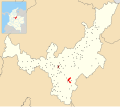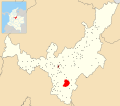| Total population | |
|---|---|
| 0 [1] (end 19th century) | |
| Regions with significant populations | |
| Boyacá, Casanare | |
| Languages | |
| Arawakan, Colombian Spanish | |
| Religion | |
| Traditional religion, Catholicism | |
| Related ethnic groups | |
| U'wa, Muisca, Achagua, Guayupe |

The Tegua or Tecua were an Arawak-speaking [2] indigenous people of Colombia who died out in the 19th century. [1]
Contents
- Etymology
- Tegua territory
- Municipalities belonging to Tegua territories
- Description
- See also
- References
The territories of the Tegua stretched from Macanal, Boyacá in the west to Aguazul in the east and from Berbeo in the north to Villanueva in the south, on the eastern flanks of the Eastern Ranges of the Colombian Andes.
Knowledge of the Tegua is scarce, [3] but has been provided by pre-modern scholars Lucas Fernández de Piedrahita, Basilio Fernández de Oviedo and Pedro Simón and in modern times by Javier Ocampo López and Pedro Gustavo Huertas Ramírez. [3] [4]












